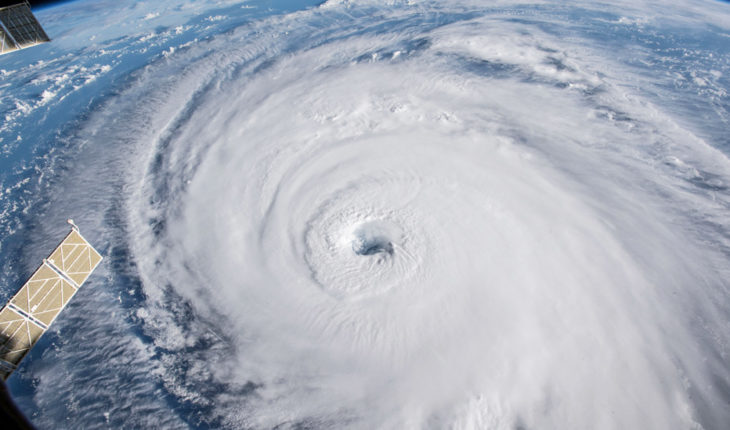Hurricane Florence weakened to category 2 in the last 24 hours, but its destructive potential is still intact.
Florence advances through the Atlantic toward the United States Coast with maximum sustained winds of 175 kilometres per hour and at a speed of 28 km / h.
In its Bulletin of 23:00 hour local (03:00 GMT on Thursday), the National Center of hurricanes, or NHC for its acronym in English, reported that the eye of Florence is 455 kilometers southeast of Wilmington, in North Carolina, and 520 in Myrtle Beach , in South Carolina.
Florence “will be close to the coasts of the Carolinas on Thursday” and “will then move close to or above” coastline between Thursday night and Friday, said the NHC.
But why it is still so dangerous if it weakened? The key lies in the classification of hurricanes, which is only based on one criterion and not reveals its ability to cause massive damage and loss of life.
Categories 1 to 5 the most powerful category that can have a hurricane 5, according to the scale used to classify these phenomena, is known as the Saffir-Simpson scale.
BBCLas divisions were created by American civil engineer Herbert Saffir, in 1969, in order to predict possible damage to structures based on the wind speed.
The scale was then expanded by Robert Simpson, former National Hurricane Center, but remains based on a single criterion, the speed of the wind.
A category 1 hurricane must have sustained winds between 119 and 153 km/h, while one category 5 has sustained winds of 250 km/h or more.
If the speed is less than 119 km/h, the phenomenon is considered a storm and not a hurricane.
“The difference between storms and hurricanes is the speed of the wind. Once you reach the sustainable winds, i.e., to stay for a minute or more, 74 miles (119 km), as category is 1 hurricane”, told BBC News the climatologa Ahira Sanchez Lugo, of the National Oceanic and atmospheric of United States , NOAA.
In a category 5 hurricane is expected that a large percentage of the houses are destroyed and much of the area is uninhabitable for weeks or months, according to the NHC.
The last Hurricane category 5, which made landfall in the United States was Hurricane Andrew in 1992.
Hurricane Maria, which left almost 3,000 dead in Puerto Rico last year, was a category 4.
Storm surge Florence is currently a category 2 hurricane. According to the NHC, these hurricanes are accompanied by “extremely dangerous winds that can cause extensive damage”.
Forecasters warn that a hurricane may be dangerous beyond their category, as demonstrated by Hurricane Sandy in 2012.
ReutersFlorence “will be close to the coasts of the Carolinas on Thursday” and “will then move close to or above” the coastal line between Thursday night and Friday, said the National Center of Huracanes.Sandy became U.S. territory with category 2 but caused flooding and left more than 50 dead in Haiti, more than 60 in the United States and at least 11 in Cuba.
Hurricane Harvey, was on the other hand, reclassified to category 3 shortly after reaching Texas last year, but in the days following intense rains caused floods and more than 80 deaths.
In the case of Florence, “are expected little change in strength before it reaches the center of the hurricane to the coast,” said the NHC.
Meteorologists warn, however, that the hurricane maintains its potential of storm surges along the coasts of North Carolina and South Carolina and can park causing heavy rains in large parts of the southeastern U.S. Coast.
Getty ImagesCosta of Wilmington, North Carolina. Florence keeps its potential of storm surges along the coasts of North Carolina and South Carolina and can park causing heavy rains. A storm surge is a coastal flood caused primarily by winds which push the ocean surface and make the water rises above the usual level of sea level.
The NHC warned that “there is the possibility of floods that threaten life” due to an increase in the sea level “moving inland” in the next 48 hours.
The storm surge will cause that areas that are typically dry near the coast “flood by an increase in the level” of the sea which could reach between 9 and 13 feet (2.7 to 4 meters) tall from Cape Fear in North Carolina to Cape Lookout in the State , with “large and destructive waves”, according to weather forecasts.
Also expected that Florence Park producing intense rainfall with total accumulations of rain between 20 and 30 inches (50-76 centimeters).
“A punch from Mike Tyson” the States of North Carolina, Georgia, Virginia, and South Carolina continue evacuation efforts and preparations before the imminent arrival of Florence.
Getty ImagesEn 2012, Sandy Hurricane became U.S. territory with category 2 but caused flooding and left more than 50 dead in Haiti, more than 60 in the United States and at least 11 in Cuba.Las authorities ordered the evacuation of more than a million and a half people in the s coastal areas of those four States, and according to preliminary, about 3.6 million users estimates could be without electricity, some of them for weeks, mostly in the eastern part of North Carolina.
“This is not going to be a scratch, this is going to be a punch from Mike Tyson to the coast of the Carolinas,” said Jeff Byard, associate director of the Federal Emergency Management Agency (FEMA), in reference to the former world champion of boxing.
“It may be the most dangerous storm in the history of the Carolinas”.
translated from Spanish: Hurricane Florence weakens but remains alert
September 13, 2018 |





